Load Forecasting with Machine Learning and Deep Learning Methods
Abstract
:1. Introduction
- The dispersion of the different AI models with respect to the real data and how each model varies in the different folds to effectively determine the variance of the results with respect to the real data.
- The tendency of the AI models to overpredict or underpredict the data in the different folds to determine the bias of these with respect to the real data.
- The projection to the future by application to a dataset used to reproduce the behavior of the AI models in a composition different from the one used in the training.
2. Related Work
- Despite the great opportunity presented by ML and DL algorithms, the characteristic variability of the different techniques has not been evaluated. Many studies focus on LSTM, MLP, RF or XGBoost but do not compare the quality of the results with those of classic ML and DL methods.
- The evaluation of the models is carried out with a multitude of techniques, without considering the independence or significance of each of the metrics used. Therefore, studies report results a priori that are precise but without any meaning beyond the value obtained.
- Many studies lack techniques that show the robustness of the models evaluated. Thus, the use of cross-validation is not common. In this way, the results shown present a great dependence on the data sample used. Therefore, the reproducibility and use of the techniques with future datasets is limited.
3. Methodology
3.1. Preprocessing
3.2. Modeling
3.2.1. Random Forest
- Robustness: It can handle electricity fluctuations due to its robustness against noise and outliers in data.
- Non-linearity: It is capable of capturing non-linear relationships effectively, allowing it to model the complex dependencies presented in the electricity consumption.
- Scalability: It can handle large datasets efficiently and scale well with increasing data information.
- Out-of-the-box performance: It provides good performance with low hyperparameter tuning.
3.2.2. Support Vector Regression
- Non-linearity: It can effectively capture non-linear relationships between electricity consumption and important features.
- Robustness to outliers: Due to its structure, it is less sensitive to outliers.
- Tunability: It has parameters that can be adjusted to control the balance between model complexity and generalization to adapt better to the fluctuations in electricity data.
- High-dimensional data: It can handle a large number of features without sacrificing performance.
3.2.3. Extreme Gradient Boosting
- Regularization and control: It offers various regularization techniques to control the complexity of the data, which prevent overfitting and improve generalization.
- Non-linearity: It captures non-linear relationships in electricity consumption to model its complex relationships.
- Scalability and efficiency: It is suitable for handling large datasets with high-dimensional feature spaces.
- Flexibility: It has a wide range of hyperparameters that can be tuned to optimize the model’s performance.
3.2.4. Multilayer Perceptron
- Non-linear: It is capable of modeling non-linear relationships.
- Flexibility and adaptability: It has a high number of hyperparameters that offers this model flexibility in terms of network architecture and activation functions.
- Missing data: It can handle missing data effectively.
- Adaptability to changing patterns: It has the ability to learn and adapt to changes in complex patterns in data.
3.2.5. Long Short-Term Memory
- Temporal modeling: It is specifically designed to model temporal dependencies in data.
- Context preservation: It can capture short-term dependencies and accommodate irregular or missing data points due to its long-term memory.
- Scalability: It can effectively capture complex patterns from extensive historical data.
- Robustness: It is robust against noise and outliers in data.
3.2.6. Temporal Convolutional Networks
- Scalability: It can handle variable-length input sequences, accommodating missing data.
- Robustness: It is robust against noise and outliers in the data since it can detect and filter the irrelevant patterns.
- Global context: It captures global information and dependencies across different time scales.
- Interpretability: It allows better understanding of the patterns that contribute to electricity consumption.
3.3. Performance Evaluations
4. Case Study
5. Results
6. Discussion
7. Conclusions
- The methodology used shows in detail the robustness and tendency of the studied models based on a comparative analysis in an effective and reliable manner.
- There is a trend suggesting that DL is better than ML, mainly due to the inclusion of missing values to conserve the data continuity.
- The performance of LSTM stands out with excellent results for predicting electrical loads, mainly because of the importance of the efficient modeling of the past input features, which in this study, were 6 h intervals.
- There is no improvement in using XGBoost over RF since these techniques seem to model the electric power demand in a similar way.
- The behavior of XGBoost, RF and Conv-1D is similar. Although they seem to follow the electric energy trends, they cannot be considered good predictors as they underestimate residual demands.
- The SNN, SVR have worse performance than LSTM.
Author Contributions
Funding
Data Availability Statement
Conflicts of Interest
Nomenclature
| Preprocessing | |
| upper bound | |
| lower bound | |
| interquartile range | |
| third quartile | |
| first quartile | |
| RF section | |
| forecasted variable | |
| number of trees | |
| probability function of the forecasted variable given the independent variables | |
| objective function | |
| number of samples | |
| difficulty of each decision tree | |
| SVR section | |
| variance | |
| point being evaluated | |
| in the hyperplane | |
| slack margin of the SVR model | |
| number of independent variables | |
| hyperparameter that represents the regularization | |
| XGBoost section | |
| the iteration considered | |
| MLP section | |
| function of the studied neuron | |
| activation function of preceding neuron | |
| LSTM section | |
| kernel of the neuron connection | |
| bias of the neuron connection | |
| forget gate | |
| kernel of the forget gate | |
| bias of the forget gate | |
| information previously kept | |
| new data | |
| Information to be updated | |
| sequence regularized | |
| kernel of the phase of information retention of the input gate | |
| bias of the phase of information retention of the input gate | |
| kernel of the phase of sequence regulation of the input gate | |
| bias of the phase of sequence regulation of the input gate | |
| previous information kept in the cell state | |
| actual information of the cell state | |
| kernel of the information previously retained together with the new data | |
| bias of the information previously retained together with the new data | |
| activation function of the actual set of information | |
| activation function of the cell state | |
| Conv-1D section | |
| feature map | |
| input vector | |
| feature detector | |
| padding | |
| stride | |
| Performance evaluation section | |
| maximum value of the objective variable | |
References
- Deb, S.; Tammi, K.; Kalita, K.; Mahanta, P. Impact of electric vehicle charging station on distribution network. Energies 2018, 11, 178. [Google Scholar] [CrossRef] [Green Version]
- Ma, X.; Wang, S.; Li, F.; Zhang, H.; Jiang, S.; Sui, M. Effect of air flow rate and temperature on the atomization characteristics of biodiesel in internal and external flow fields of the pressure swirl nozzle. Energy 2022, 253, 124112. [Google Scholar] [CrossRef]
- Kakandwar, S.; Bhushan, B.; Kumar, A. Chapter 3—Integrated machine learning techniques for preserving privacy in Internet of Things (IoT) systems. In Blockchain Technology Solutions for the Security of IoT-Based Healthcare Systems; Academic Press: Cambridge, MA, USA, 2023; pp. 45–75. [Google Scholar] [CrossRef]
- Sheena, N.; Joseph, S.; Sivan, S.; Bhushan, B. Light-weight privacy enabled topology establishment and communication protocol for swarm IoT networks. Clust. Comput. 2022, in press. [Google Scholar] [CrossRef]
- International Energy Agency. Appliances and Equipment; International Energy Agency: Paris, France, 2020.
- Chauhan, R.K.; Chauhan, K. Building automation system for grid-connected home to optimize energy consumption and electricity bill. J. Build. Eng. 2019, 21, 409–420. [Google Scholar] [CrossRef]
- Yu, L.; Qin, S.; Zhang, M.; Shen, C.; Jiang, T.; Guan, X. A review of Deep Reinforcement Learning for smart building energy management. IEEE Internet Things J. 2021, 8, 12046–12063. [Google Scholar] [CrossRef]
- Thomas, D.; Deblecker, O.; Ioakimidis, C.S. Optimal operation of an energy management system for a grid-connected smart building considering photovoltaics’ uncertainty and stochastic electric vehicles’ driving schedule. Appl. Energy 2018, 210, 1188–1206. [Google Scholar] [CrossRef]
- European Commission. A European Long-Term Strategic Vision for a Prosperous, Modern, Competitive and Climate Neutral Economy; EU: Brussels, Belgium, 2018.
- International Energy Agency. Energy Efficiency 2018. Analysis and Outlooks to 2040; EU: Paris, France, 2018.
- Villanueva, D.; Cordeiro-Costas, M.; Feijoó-Lorenzo, A.E.; Fernández-Otero, A.; Míguez-García, E. Towards DC Energy Efficient Homes. Appl. Energy 2021, 11, 6005. [Google Scholar] [CrossRef]
- Xiong, R.; Cao, J.; Yu, Q. Reinforcement learning-based real-time power management for hybrid energy storage system in the plug-in hybrid electric vehicle. Appl. Energy 2018, 211, 538–548. [Google Scholar] [CrossRef]
- Tostado-Véliz, M.; Icaza-Alvarez, D.; Jurado, F. A novel methodology for optimal sizing photovoltaic-battery systems in smart homes considering grid outages and demand response. Renew. Energy 2021, 170, 884–896. [Google Scholar] [CrossRef]
- Nematchoua, M.K.; Marie-Reine Nishimwe, A.; Reiter, S. Towards nearly zero-energy residential neighbourhoods in the European Union: A case study. Renew. Sustain. Energy Rev. 2021, 135, 110198. [Google Scholar] [CrossRef]
- Brambilla, A.; Salvalai, G.; Imperadori, M.; Sesana, M.M. Nearly zero energy building renovation: From energy efficiency to environmental efficiency, a pilot case study. Energy Build. 2018, 166, 271–283. [Google Scholar] [CrossRef]
- Cordeiro-Costas, M.; Villanueva, D.; Eguía-Oller, P. Optimization of the Electrical Demand of an Existing Building with Storage Management through Machine Learning Techniques. Appl. Sci. 2021, 11, 7991. [Google Scholar] [CrossRef]
- Zhang, Q.; Yang, L.T.; Chen, Z.; Li, P. A survey on deep learning for big data. Inf. Fusion 2018, 42, 146–157. [Google Scholar] [CrossRef]
- Langer, L.; Volling, T. An optimal home energy management system for modulating heat pumps and photovoltaic systems. Appl. Energy 2020, 278, 115661. [Google Scholar] [CrossRef]
- Oh, S. Comparison of a Response Surface Method and Artificial Neural Network in Predicting the Aerodynamic Performance of a Wind Turbine Airfoil and Its Optimization. Appl. Sci. 2020, 10, 6277. [Google Scholar] [CrossRef]
- Thesia, Y.; Oza, V.; Thakkar, P. A dynamic scenario-driven technique for stock price prediction and trading. J. Forecast. 2022, 41, 653–674. [Google Scholar] [CrossRef]
- Runge, J.; Zmeureanu, R. Forecasting Energy Use in Buildings Using Artificial Neural Networks: A Review. Energies 2019, 12, 3254. [Google Scholar] [CrossRef] [Green Version]
- Habbak, H.; Mahmoud, M.; Metwally, K.; Fouda, M.M.; Ibrahem, M.I. Load Forecasting Techniques and Their Applications in Smart Grids. Energies 2023, 16, 1480. [Google Scholar] [CrossRef]
- López-Santos, M.; Díaz-García, S.; García-Santiago, X.; Ogando-Martínez, A.; Echevarría-Camarero, F.; Blázquez-Gil, G.; Carrasco-Ortega, P. Deep Learning and transfer learning techniques applied to short-term load forecasting of data-poor buildings in local energy communities. Energy Build. 2023, 292, 113164. [Google Scholar] [CrossRef]
- Madler, J.; Harding, S.; Weibelzahl, M. A multi-agent model of urban microgrids: Assessing the effects of energy-market shocks using real-world data. Appl. Energy 2023, 343, 121180. [Google Scholar] [CrossRef]
- Sethi, R.; Kleissl, J. Comparison of Short-Term Load Forecasting Techniques. In Proceedings of the 2020 IEEE Conference on Technologies for Sustainability (SusTech), Santa Ana, CA, USA, 23–25 April 2020. [Google Scholar] [CrossRef]
- Chou, J.S.; Tran, D.S. Forecasting energy consumption time series using machine learning techniques based on usage patterns of residential householders. Energy 2018, 165, 709–726. [Google Scholar] [CrossRef]
- Rafi, S.H.; Al-Masood, N.; Deeba, S.R.; Hossain, E. A Short-Term Load Forecasting Method Using Integrated CNN and LSTM Network. IEEE Access 2021, 9, 32436–32448. [Google Scholar] [CrossRef]
- Ye, Z.; Kim, M.K. Predicting electricity consumption in a building using an optimized back-propagation and Levenberg-Marquardt back-propagation neural network: Case study of a shopping mall in China. Sustain. Cities Soc. 2018, 42, 176–183. [Google Scholar] [CrossRef]
- Wang, C.; Baratchi, M.; Back, T.; Hoos, H.H.; Limmer, S.; Olhofer, M. Towards Time-Series Feature Engineering in Automated Machine Learning for Multi-Step-Ahead Forecasting. Eng. Proc. 2022, 18, 8017. [Google Scholar] [CrossRef]
- Fan, C.; Sun, Y.; Zhao, Y.; Song, M.; Wang, J. Deep learning-based feature engineering methods for improved building energy prediction. Appl. Energy 2019, 240, 35–45. [Google Scholar] [CrossRef]
- Tian, C.; Li, C.; Zhang, G.; Lv, Y. Data driven parallel prediction of building energy consumption using generative adversarial nets. Energy Build. 2019, 186, 230–243. [Google Scholar] [CrossRef]
- Dab, K.; Agbossou, K.; Henao, N.; Dubé, Y.; Kelouwani, S.; Hosseini, S.S. A compositional kernel based gaussian process approach to day-ahead residential load forecasting. Energy Build. 2022, 254, 111459. [Google Scholar] [CrossRef]
- Zeyu, W.; Yueren, W.; Rouchen, Z.; Srinivasan, R.S.; Ahrentzen, S. Random Forest based hourly building energy prediction. Energy Build. 2018, 171, 11–25. [Google Scholar] [CrossRef]
- Touzani, S.; Granderson, J.; Fernandes, S. Gradient boosting machine for modelling the energy consumption of commercial buildings. Energy Build. 2018, 158, 1533–1543. [Google Scholar] [CrossRef] [Green Version]
- Hadri, S.; Naitmalek, Y.; Najib, M.; Bakhouya, M.; Fakhiri, Y.; Elaroussi, M. A Comparative Study of Predictive Approaches for Load Forecasting in Smart Buildings. Procedia Comput. Sci. 2019, 160, 173–180. [Google Scholar] [CrossRef]
- Vrablecová, P.; Bou Ezzeddine, A.; Rozinajová, V.; Šárik, S.; Sangaiah, A.K. Smart grid load forecasting using online support vector regression. Comput. Electr. Eng. 2018, 65, 102–117. [Google Scholar] [CrossRef]
- Khan, S.; Javaid, N.; Chand, A.; Khan, A.B.M.; Rashid, F.; Afridi, I.U. Electricity Load Forecasting for Each Day of Week Using Deep CNN. Adv. Intell. Syst. Comput. 2019, 927, 1107–1119. [Google Scholar] [CrossRef]
- Chen, S.; Ren, Y.; Friedrich, D.; Yu, Z.; Yu, J. Prediction of office building electricity demand using artificial neural network by splitting the time horizon for different occupancy rates. Energy AI 2021, 5, 100093. [Google Scholar] [CrossRef]
- Amber, K.P.; Ahmad, R.; Aslam, M.W.; Kousar, A.; Usman, M.; Khan, M.S. Intelligent techniques for forecasting electricity consumption of buildings. Energy 2018, 157, 886–893. [Google Scholar] [CrossRef]
- Zhong, H.; Wang, J.; Jia, H.; Mu, Y.; Lv, S. Vector field-based support vector regression for building energy consumption prediction. Appl. Energy 2019, 242, 403–414. [Google Scholar] [CrossRef]
- Martínez-Comesaña, M.; Febrero-Garrido, M.; Granada-Álvarez, E.; Martínez-Torres, J.; Martínez-Mariño, S. Heat Loss Coefficient Estimation Applied to Existing Buildings through Machine Learning Models. Appl. Sci. 2020, 10, 8968. [Google Scholar] [CrossRef]
- Werner de Vargas, V.; Schneider Aranda, J.A.; dos Santos Costa, R.; da Silva Pereira, P.R.; Victória Barbosa, J.L. Imbalanced data preprocesing techniques for machine learning: A systematic mapping study. Knowl. Inf. Syst. 2023, 65, 31–57. [Google Scholar] [CrossRef]
- Ur Rehman, A.; Belhaouari, S.B. Unsupervised outlier detection in multidimensional data. J. Big Data 2021, 8, 80. [Google Scholar] [CrossRef]
- Bazlur Rashid, A.N.M.; Ahmed, M.; Pathan, A.K. Infrequent pattern detection for reliable network traffic analysis using robust evolutionary computation. Sensors 2021, 21, 3005. [Google Scholar] [CrossRef]
- Cordeiro-Costas, M.; Villanueva, D.; Eguía-Oller, P.; Granada-Álvarez, E. Machine Learning and Deep Learning Models Applied to Photovoltaic Production Forecasting. Appl. Sci. 2022, 12, 8769. [Google Scholar] [CrossRef]
- Xiong, Z.; Cui, Y.; Liu, Z.; Zhao, Y.; Hu, M.; Hu, J. Evaluating explorative prediction power of machine learning algorithms for materials discovery using k-fold forward cross-validation. Comput. Mater. Sci. 2020, 171, 109203. [Google Scholar] [CrossRef]
- Feng, Y.; Tu, Y. Phases of learning dynamics in artificial neural networks in the absence or presence of mislabeled data. Mach. Learn. Sci. Technol. 2021, 2, 043001. [Google Scholar] [CrossRef]
- Smith, G.D.; Ching, W.H.; Cornejo-Páramo, P.; Wong, E.S. Decoding enhancer complexity with machine learning and high-throughput discovery. Genome Biol. 2023, 24, 116. [Google Scholar] [CrossRef] [PubMed]
- Olu-Ajayi, R.; Alaka, H.; Owolabi, H.; Akanbi, L.; Ganiyu, S. Data-Driven Tools for Building Energy Consumption Prediction: A Review. Energies 2023, 16, 2574. [Google Scholar] [CrossRef]
- Ai, H.; Zhang, K.; Sun, J.; Zhang, H. Short-term Lake Erie algal bloom prediction by classification and regression models. Water Res. 2023, 232, 119710. [Google Scholar] [CrossRef]
- Park, H.J.; Kim, Y.; Kim, H.Y. Stock market forecasting using a multi-task approach integrating long short-term memory and the random forest framework. Appl. Soft Comput. 2022, 114, 1081106. [Google Scholar] [CrossRef]
- Roy, A.; Chakraborty, S. Support vector machine in structural reliability analysis: A review. Reliab. Eng. Syst. Saf. 2023, 233, 109126. [Google Scholar] [CrossRef]
- Alrobaie, A.; Krati, M. A Review of Data-Driven Approaches for Measurement and Verification Analysis of Building Energy Retrofits. Energies 2022, 15, 7824. [Google Scholar] [CrossRef]
- Pimenov, D.Y.; Dustillo, A.; Wojciechowski, S.; Sharma, V.S.; Gupta, M.K.; Kontoglu, M. Artificial intelligence systems for tool condition monitoring in machining: Analysis and critical review. J. Intell. Manuf. 2023, 34, 2079–2121. [Google Scholar] [CrossRef]
- Huang, K.; Guo, Y.F.; Tseng, M.L.; Wu, K.J.; Li, Z.G. A Novel Health Factor to Predict the Battery’s State-of-Health Using a Support Vector Machine Approach. Appl. Sci. 2018, 8, 1803. [Google Scholar] [CrossRef] [Green Version]
- Jassim, M.A.; Abd, D.H.; Omri, M.N. Machine learning-based new approach to films review. Soc. Netw. Anal. Min. 2023, 13, 40. [Google Scholar] [CrossRef]
- Yang, L.; Shami, A. IoT data analytics in dynamic environments: From an automated machine learning perspective. Eng. Appl. Artif. Intell. 2022, 116, 105366. [Google Scholar] [CrossRef]
- Priscilla, C.V.; Prabha, D.P. Influence of Optimizing XGBoost to Handle Class Imbalance in Credit Card Fraud Detection. In Proceedings of the 2020 Third International Conference on Smart Systems and Inventive Technology (ICSSIT), Tirunelveli, India, 20–22 August 2020; pp. 1309–1315. [Google Scholar] [CrossRef]
- Cao, J.; Gao, J.; Nikafshan Rad, H.; Mohammed, A.S.; Hasanipanah, M.; Zhou, J. A novel systematic and evolved approach based on XGBoost-firefly algorithm to predict Young’s modulus and unconfined compressive strength of rock. Eng. Comput. 2022, 38, 3829–3845. [Google Scholar] [CrossRef]
- Bienvenido-Huertas, D.; Sánchez-García, D.; Marín-García, D.; Rubio-Bellido, C. Analysing energy poverty in warm climate zones in Spain through artificial intelligence. J. Build. Eng. 2023, 68, 106116. [Google Scholar] [CrossRef]
- Qin, Y.; Luo, H.; Zhao, F.; Fang, Y.; Tao, X.; Wang, C. Spatio-temporal hierarchical MLP network for traffic forecasting. Inf. Sci. 2023, 632, 543–554. [Google Scholar] [CrossRef]
- Li, H.; Gao, W.; Xie, J.; Yen, G.G. Multiobjective bilevel programming model for multilayer perceptron neural networks. Inf. Sci. 2023, 642, 119031. [Google Scholar] [CrossRef]
- Lee, D.H.; Lee, D.; Han, S.; Seo, S.; Lee, B.J.; Ahn, J. Deep residual neural network for predicting aerodynamic coefficient changes with ablation. Aerosp. Sci. Technol. 2023, 136, 108207. [Google Scholar] [CrossRef]
- Panerati, J.; Schnellmann, M.-A.; Patience, C.; Beltrame, G.; Patience, G.-S. Experimental methods in chemical engineering: Artificial neural networks-ANNs. Can. J. Chem. Eng. 2019, 97, 2372–2382. [Google Scholar] [CrossRef]
- Marfo, K.F.; Przybyla-Kasperek, M. Study on the Use of Artificially Generated Objects in the Process of Training MLP Neural Networks Based on Dispersed Data. Entropy 2023, 25, 703. [Google Scholar] [CrossRef]
- Dai, C.; Wei, Y.; Xu, Z.; Chen, M.; Liu, Y.; Fan, J. ConMLP: MLP-Based Self-Supervised Contrastive Learning for Skeleton Data Analysis and Action Recognition. Sensors 2023, 23, 2452. [Google Scholar] [CrossRef]
- Zhao, R.; Yang, R.; Chen, Z.; Mao, K.; Wang, P.; Gao, R.-X. Deep learning and its applications to machine health monitoring. Mech. Syst. Signal Process. 2019, 115, 213–237. [Google Scholar] [CrossRef]
- Pal, P.; Chattopadhyay, P.; Swarnkar, M. Temporal feature aggregation with attention for insider threat detection from activity logs. Expert Syst. Appl. 2023, 224, 119925. [Google Scholar] [CrossRef]
- Sareen, K.; Panigrahi, B.K.; Shikhola, T.; Sharma, R. An imputation and decomposition algorithms based integrated approach with bidirectional LSTM neural network for wind speed prediction. Energy 2023, 278, 127799. [Google Scholar] [CrossRef]
- Laib, O.; Khadir, M.T.; Mihaylova, L. Toward efficient energy systems based on natural gas consumption prediction with LSTM Recurrent Neural Networks. Energy 2019, 177, 530–542. [Google Scholar] [CrossRef]
- Zhao, H.; Sun, S.; Jin, B. Sequential Fault Diagnosis Based on LSTM Neural Network. IEEE Access 2018, 6, 12929–12939. [Google Scholar] [CrossRef]
- Zaman, S.K.U.; Jehangiri, A.I.; Maqsood, T.; Umar, A.I.; Khan, M.A.; Jhanjhi, N.Z.; Shorfuzzaman, M.; Masud, M. COME-UP: Computation Offloading in Mobile Edge Computing with LSTM Based User Direction Prediction. Appl. Sci. 2022, 12, 3312. [Google Scholar] [CrossRef]
- Lablack, M.; Shen, Y. Spatio-temporal graph mixformer for traffic forecasting. Expert Syst. Appl. 2023, 228, 120281. [Google Scholar] [CrossRef]
- Ju, T.; Sun, G.; Chen, Q.; Zhang, M.; Zhu, H.; Rehman, M.U. A model combining convolutional neural network and lightgbm algorithm for ultra-short term wind power forecasting. IEEE Access 2019, 7, 28309–28318. [Google Scholar] [CrossRef]
- Zhang, Q.; Jin, Q.; Chang, J.; Xiang, S.; Pan, C. Kernel-Weighted Graph Convolutional Network: A Deep Learning Approach for Traffic Forecasting. In Proceedings of the 24th International Conference on Pattern Recognition (ICPR 2018), Beijing, China, 20–24 August 2018; pp. 1018–1023. [Google Scholar] [CrossRef]
- Mitra, S. Deep Learning with Radiogenomics towards Personalized Management of Gliomas. IEEE Rev. Biomed. Eng. 2023, 16, 579–593. [Google Scholar] [CrossRef]
- Borghesi, M.; Costa, L.D.; Morra, L.; Lamberti, F. Using Temporal Convolutional Networks to estimate ball possession in soccer games. Expert Syst. Appl. 2023, 223, 119780. [Google Scholar] [CrossRef]
- Velayuthapandian, K.; Subramoniam, S.P. A focus module-based lightweight end-to-end CNN framework for voiceprint recognition. Signal Image Video Process. 2023, 17, 2817–2825. [Google Scholar] [CrossRef]
- Goay, C.H.; Ahmad, N.S.; Goh, P. Temporal convolutional networks for transient simulation of high-speed channels. Alex. Eng. J. 2023, 74, 643–663. [Google Scholar] [CrossRef]
- Taqi, A.M.; Awad, A.; Al-Azzo, F.; Milanova, M. The Impact of Multi-Optimizers and Data Augmentation on TensorFlow Convolutional Neural Network Performance. In Proceedings of the 1st IEEE Conference on Multimedia Information Processing and Retrieval (MIPR 2018), Miami, FL, USA, 10–12 April 2018; pp. 140–145. [Google Scholar] [CrossRef]
- Zhang, J.; Lu, C.; Li, X.; Kim, H.J.; Wang, J. A Full Convolutional Network Based on DenseNet for remote sensing scene classification. Math. Biosci. Eng. 2019, 16, 3345–3367. [Google Scholar] [CrossRef] [PubMed]
- William, H.; Fanney, A.H.; Dougherty, B.; Payne, W.V.; Ullah, T.; Ng, L.; Omar, F. Net Zero Energy Residential Test Facility Instrumented Data; Year 2. 2017. Available online: https://pages.nist.gov/netzero/data.html (accessed on 3 July 2023).
- William, H.; Chen, T.H.; Dougherty, B.; Fanney, A.H.; Ullah, T.; Payne, W.V.; Ng, L.; Omar, F. Net Zero Energy Residential Test Facility Instrumented Data; Year 1. 2018. Available online: https://pages.nist.gov/netzero/ (accessed on 3 July 2023).
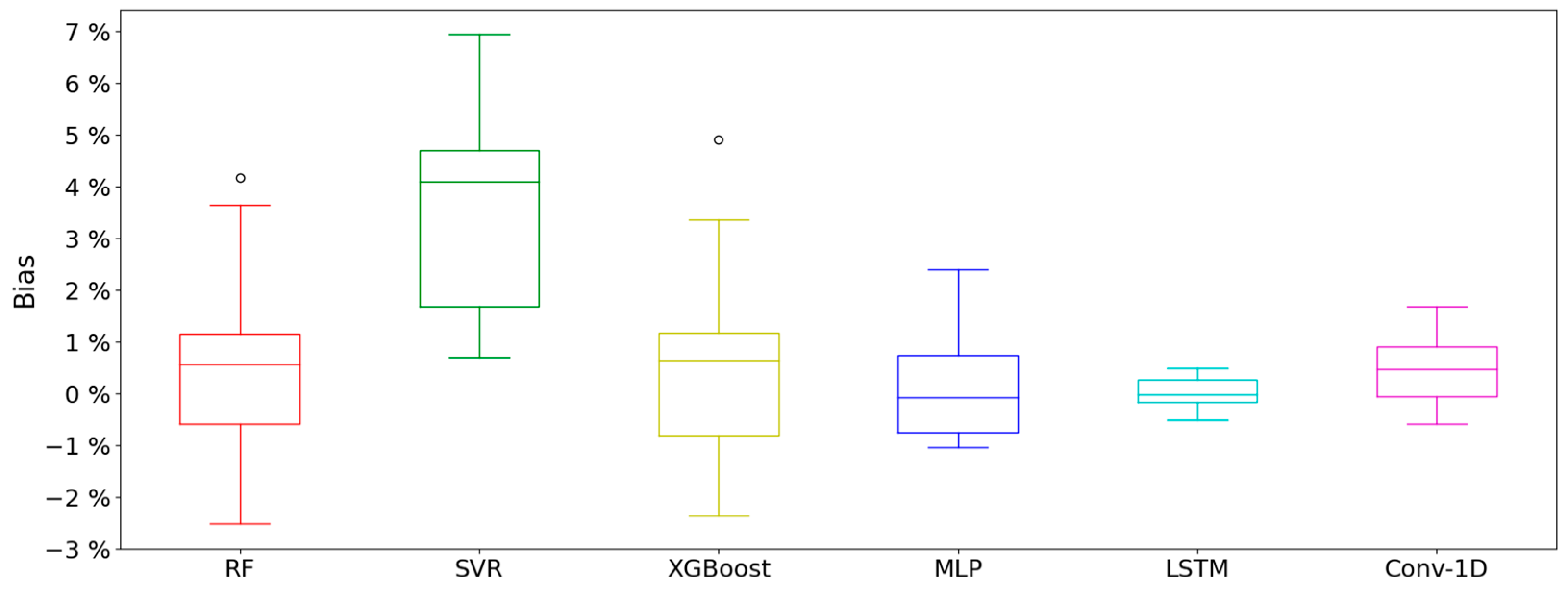
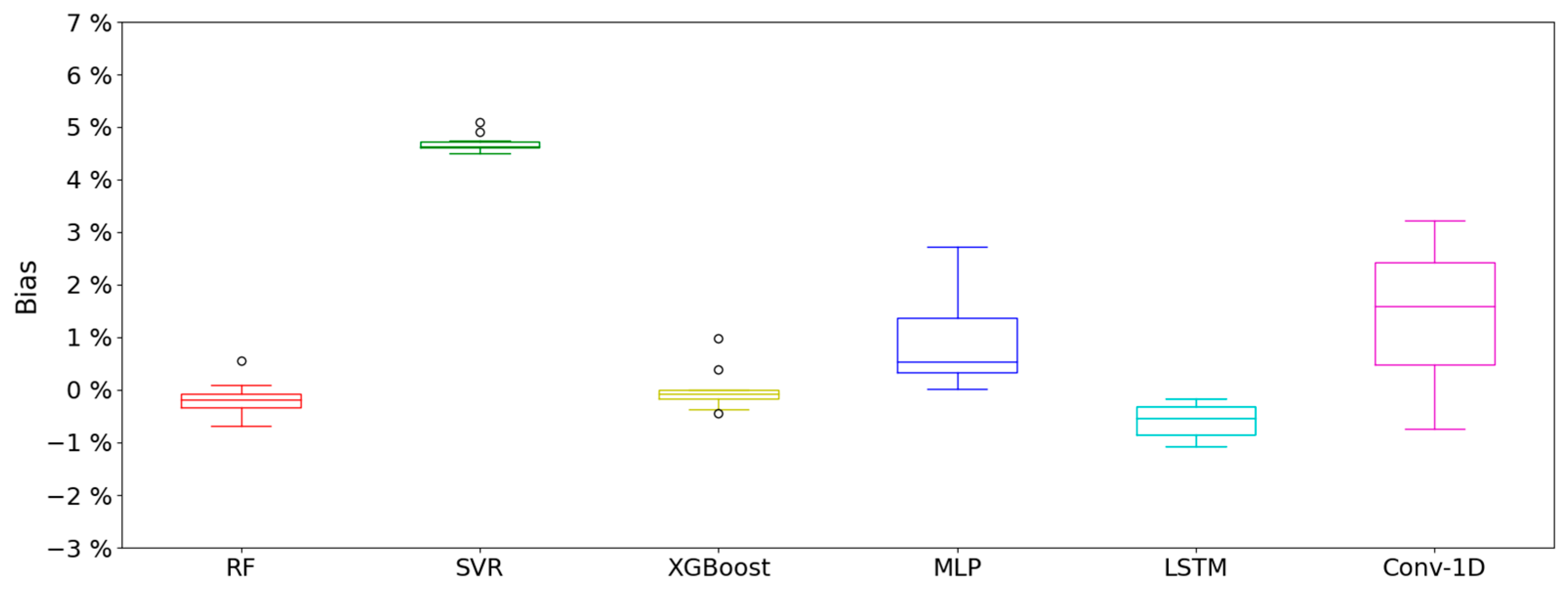

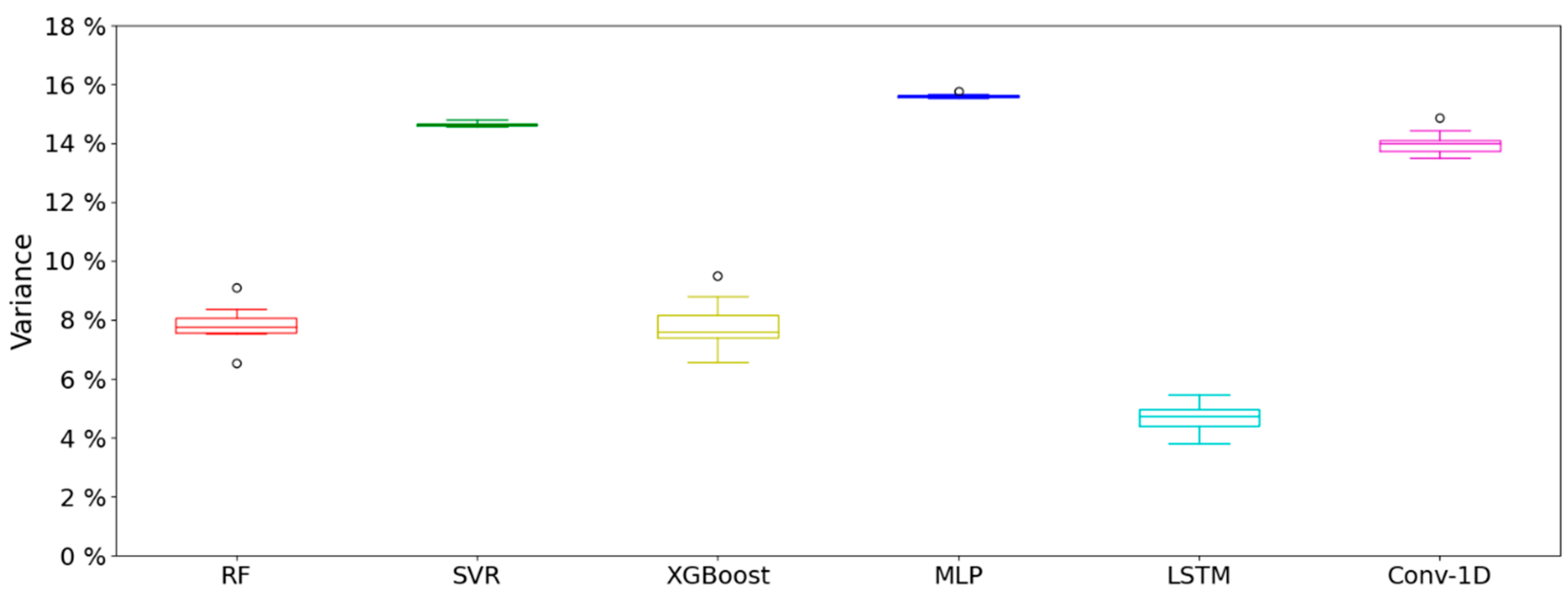
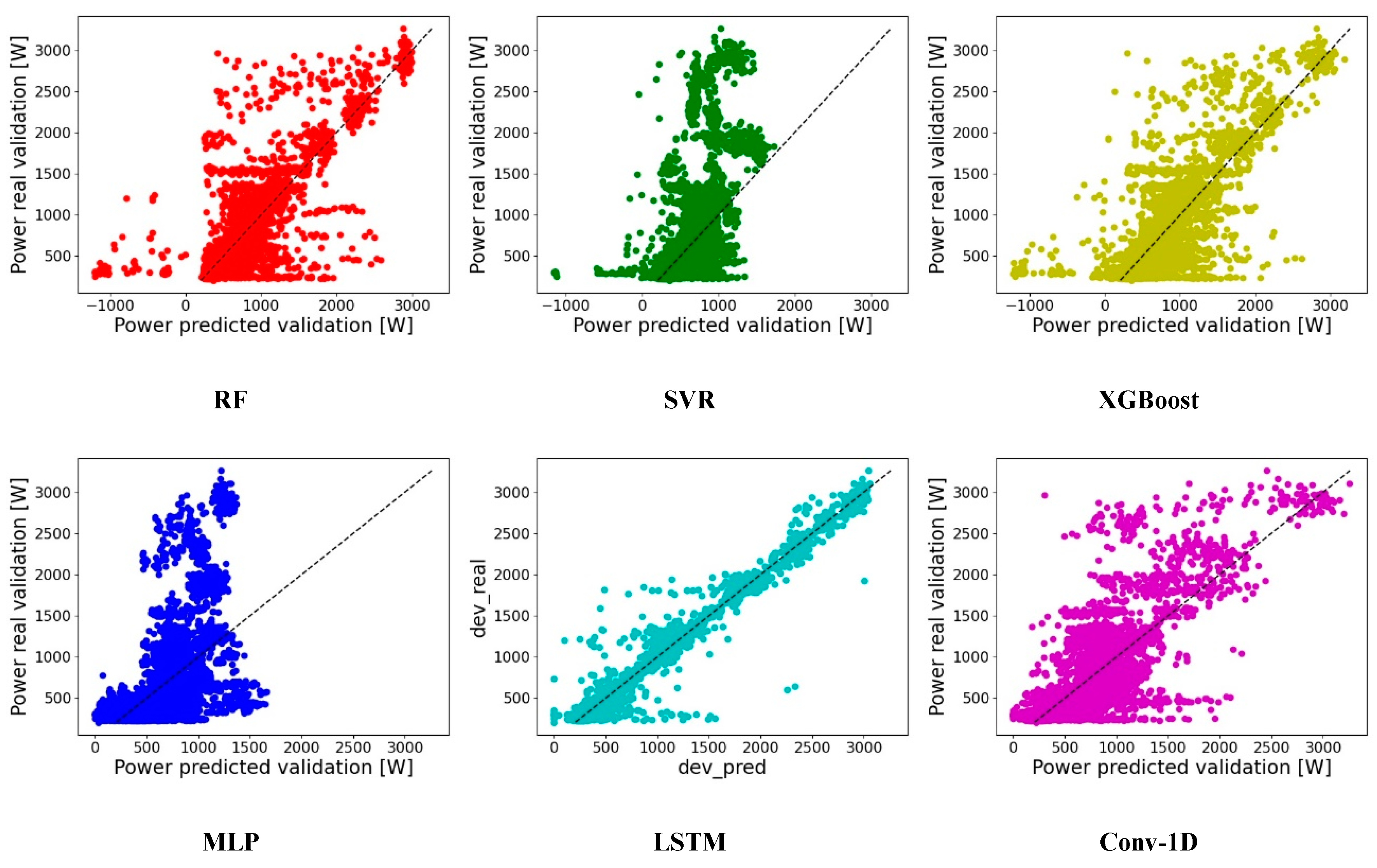
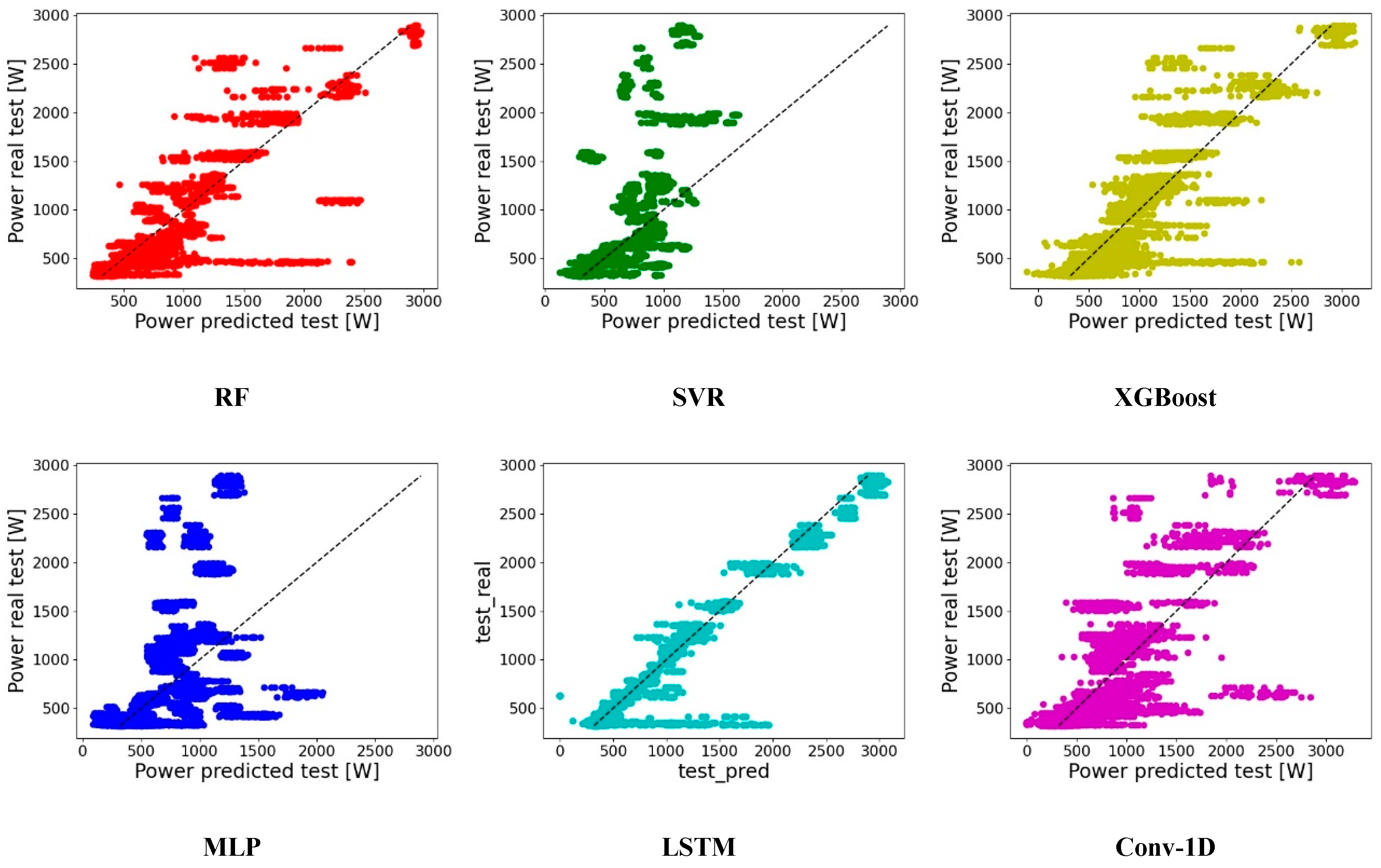
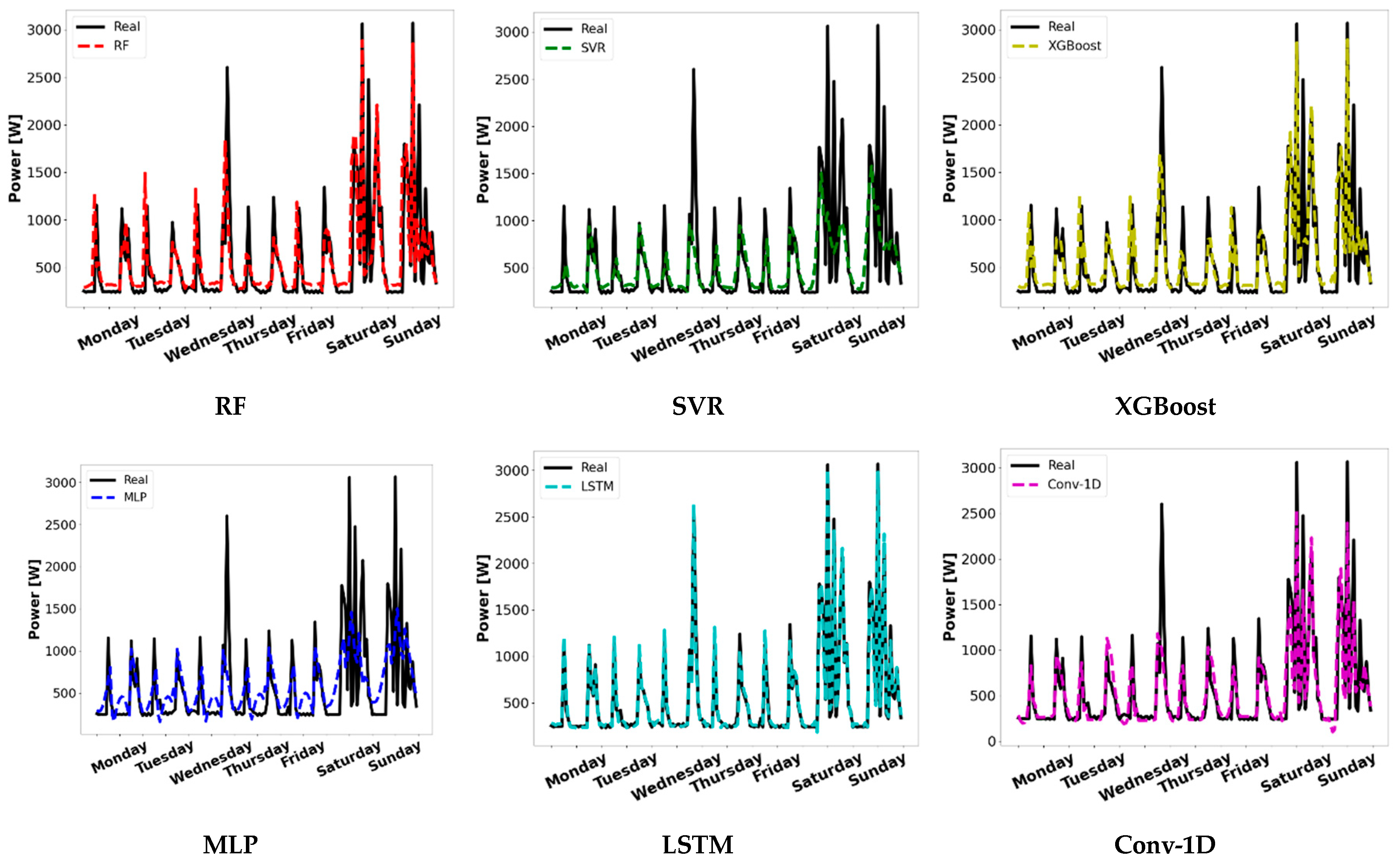

| Paper ID | Models | Temporal Granularity | Error Metrics | Cross-Validation | Test Set |
|---|---|---|---|---|---|
| [31] | MLP, XGBoost, SVR | 30 min | MAE, MAPE, R | No | No |
| [27] | LSTM, CNN-LSTM, XGBoost, RBFN | 30 min | RMSE, MAPE, MAE, R2 | No | Yes (16%) |
| [32] | SVR, LSTM, RF, GP | 1 h | MAE, sMAPE, RMSE | No | No |
| [28] | MLP, LM-MLP | 1 day | MAE, RMSE | No | Yes (30%) |
| [33] | RF, RT, SVR | 1 h | PI, RMSE, MAPE, R2 | No | Yes (20%) |
| [34] | GBoost, RF, TOTW | 15 min | R2, CV(RMSE), nMBE | Yes, 5 folds | No |
| [25] | ARIMA, LR, LSTM | 1 h | RMSE, MBE | No | Yes (25%) |
| [26] | MLP, SVR, RT, LR, SARIMA | 15 min | R, RMSE, MAE, MAPE, MaxAE | No | Yes (1 day) |
| [35] | ARIMA, SARIMA, XGBoost, RF, LSTM | 1 h | MPE, MAPE, MAE, RMSE | No | Yes (40%) |
| [36] | SVR, RF, XGBoost, MLP | 30 min | MAPE | No | Yes (1 month) |
| [37] | LSTM, CNN, ARIMA, MLP | 30 min | MAPE, MAE, RMSE | No | Yes (1 day) |
| [38] | MLP | 1 h | RMSE | No | Yes (30%) |
| [39] | LR, GP, MLP, SVR | 1 h | RMSE, MAE, MRE, MAPE, nRMSE | No | Yes (20%) |
| [40] | LR, SVR, MLP, EDL, GBoost | 1 h | R, MAE, RMSE, RAE, RRSE | Yes, 5 folds | Yes (30%) |
| [41] | XGBoost, SVR, MLP | 1 h | CV(RMSE), nMBE | Yes, 3 folds | No |
| Model | Hyperparameter | Selected Value |
|---|---|---|
| All | Patience | 100 epochs |
| Batch size | 64 | |
| Optimizer | Adam | |
| Learning rate | 0.001 | |
| SVR | Tolerance | 0.001 |
| Regularization | 1 | |
| MLP | Hidden layers | 4 |
| Nodes of the hidden layers | 100, 75, 50, 25 | |
| Activations of the hidden layers | linear, linear, linear, ReLU | |
| DL | Activation of the output layer | ReLU |
| LSTM | Short memory | 6 timesteps |
| Hidden layers | 3 | |
| Type of hidden layers | LSTM, dense, dense | |
| Nodes of the hidden layers | 64, 40, 20 | |
| Activations of the hidden layers | predefined, linear, ReLU | |
| Conv-1D | Hidden layers | 3 |
| Type of hidden layers | LSTM, dense, dense | |
| Nodes of the hidden layers | 64, 40, 20 | |
| Activations of the hidden layers | linear, linear, ReLU | |
| Filters | 64 | |
| Feature detector | 3 | |
| Padding | 0 | |
| Stride | 1 |
| Split | Metric | Quartile | RF | SVR | XGBoost | MLP | LSTM | Conv-1D |
|---|---|---|---|---|---|---|---|---|
| Validation | nMBE | Median | 0.56% | 4.11% | 0.64% | −0.08% | −0.02% | 0.48% |
| IQR | 1.73% | 3.03% | 1.98% | 1.49% | 0.44% | 0.97% | ||
| nRMSE | Median | 9.44% | 13.80% | 9.33% | 14.32% | 2.76% | 9.64% | |
| IQR | 2.39% | 0.57% | 1.59% | 0.43% | 1.71% | 1.76% | ||
| Test | nMBE | Median | −0.19% | 4.63% | −0.07% | 0.53% | −0.54% | 1.59% |
| IQR | 0.25% | 0.12% | 0.16% | 1.04% | 0.52% | 1.93% | ||
| nRMSE | Median | 7.75% | 14.62% | 7.59% | 15.59% | 4.74% | 14.00% | |
| IQR | 0.52% | 0.09% | 0.76% | 0.06% | 0.58% | 0.36% |
Disclaimer/Publisher’s Note: The statements, opinions and data contained in all publications are solely those of the individual author(s) and contributor(s) and not of MDPI and/or the editor(s). MDPI and/or the editor(s) disclaim responsibility for any injury to people or property resulting from any ideas, methods, instructions or products referred to in the content. |
© 2023 by the authors. Licensee MDPI, Basel, Switzerland. This article is an open access article distributed under the terms and conditions of the Creative Commons Attribution (CC BY) license (https://creativecommons.org/licenses/by/4.0/).
Share and Cite
Cordeiro-Costas, M.; Villanueva, D.; Eguía-Oller, P.; Martínez-Comesaña, M.; Ramos, S. Load Forecasting with Machine Learning and Deep Learning Methods. Appl. Sci. 2023, 13, 7933. https://doi.org/10.3390/app13137933
Cordeiro-Costas M, Villanueva D, Eguía-Oller P, Martínez-Comesaña M, Ramos S. Load Forecasting with Machine Learning and Deep Learning Methods. Applied Sciences. 2023; 13(13):7933. https://doi.org/10.3390/app13137933
Chicago/Turabian StyleCordeiro-Costas, Moisés, Daniel Villanueva, Pablo Eguía-Oller, Miguel Martínez-Comesaña, and Sérgio Ramos. 2023. "Load Forecasting with Machine Learning and Deep Learning Methods" Applied Sciences 13, no. 13: 7933. https://doi.org/10.3390/app13137933
APA StyleCordeiro-Costas, M., Villanueva, D., Eguía-Oller, P., Martínez-Comesaña, M., & Ramos, S. (2023). Load Forecasting with Machine Learning and Deep Learning Methods. Applied Sciences, 13(13), 7933. https://doi.org/10.3390/app13137933








